|
Journey to the Omo Valley in
Southern Ethiopia
Photos
and article by Muguette Goufrani
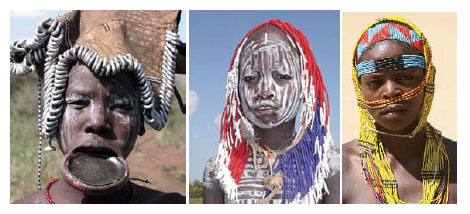 I
am Ethiopia. Long before the Queen of Sheba, King
Lalibela and other icons from the pages of of
history walked my sacred land, an area many call
the "Cradle of Civilization," visitors from near
and far arrived to sample my diverse culture and
mingle with over 80 ethnic groups that form a
unique mosaic. Most Ethiopians speak Amharic, my
official language, however many are very much at
ease in English, Italian and Arabic when doing
business. Friendly and fiercely proud of their
ancient heritage, my indigenous people are an
exotic blend of African, Judaic and Egyptian
influences. I
am Ethiopia. Long before the Queen of Sheba, King
Lalibela and other icons from the pages of of
history walked my sacred land, an area many call
the "Cradle of Civilization," visitors from near
and far arrived to sample my diverse culture and
mingle with over 80 ethnic groups that form a
unique mosaic. Most Ethiopians speak Amharic, my
official language, however many are very much at
ease in English, Italian and Arabic when doing
business. Friendly and fiercely proud of their
ancient heritage, my indigenous people are an
exotic blend of African, Judaic and Egyptian
influences.
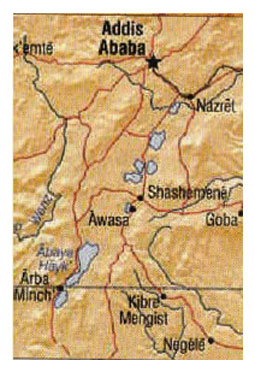 I
am Ethiopia, land of many rivers. The culture of my
Omo people is steeped in rich tradition and
colorful history. Many of them live along the Omo
River. To those who love adventure the Omo is
famous for white water rafting, as it tumbles its
way through a steep valley before entering Lake
Turkana. From the water, varied scenery, with
forests of tamarind, alive with Colobus monkeys and
flocks of colorful birds confronts the visitor. On
the savannah slopes against a brilliantly lit
mountain backdrop, you will find waterbucks and
bushbuck. At a riverside camp, you will encounter
water fowl, hippos, antelope, baboons and even
lions. Such a river adventure also provides an
opportunity to visit indigenous tribes along the
way, at places such as Tumele, one of the larger
Karo villages. I
am Ethiopia, land of many rivers. The culture of my
Omo people is steeped in rich tradition and
colorful history. Many of them live along the Omo
River. To those who love adventure the Omo is
famous for white water rafting, as it tumbles its
way through a steep valley before entering Lake
Turkana. From the water, varied scenery, with
forests of tamarind, alive with Colobus monkeys and
flocks of colorful birds confronts the visitor. On
the savannah slopes against a brilliantly lit
mountain backdrop, you will find waterbucks and
bushbuck. At a riverside camp, you will encounter
water fowl, hippos, antelope, baboons and even
lions. Such a river adventure also provides an
opportunity to visit indigenous tribes along the
way, at places such as Tumele, one of the larger
Karo villages.
Karo, Muguji and
Mursi
The Karo people are outstanding in face and
body painting, a common practice in preparation for
dances and ceremonies. They combine pulverized
white chalk and yellow rock, reddish iron ore
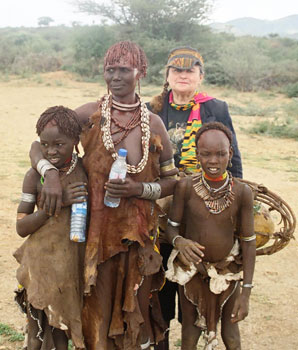 and
black charcoal to decorate their bodies. You can
boat to visit the Muguji tribal area for an
immersion in Muguji culture. The Muguji trap small
game and collect honey and wild fruits. Great
fishermen, one of the Muguji specialties is hunting
crocodiles. The Mursi tribe is famous worldwide for
the clay lip dishes, originally worn by the women,
as a means of avoiding capture as slaves. Just so
you know, they remove the clay plates at meal time.
Surrounded by mountains and three rivers, the Mursi
homeland is one of my most isolated regions. Like
the Maasai of neighboring Kenya, the Mursi have a
fierce reputation as guardians of their precious
grazing lands. The men often wore light scars on
their shoulders after killing an enemy and have
geometric patterns on their heads. For dances and
ceremonies they adorn their bodies with white
chalk. The Nyagatom live on the Omo River's western
banks near the Kenya border. Numbering over 7,000,
they have a war-like history. Small groups living
along the Omo specialize in hunting crocodiles,
usually from a light dugout canoes, using harpoons.
The men wear a blue and ochre clay clair hair bun
with ostrich feathers. The elders of both sexes
wear a plug on their lower lip - the female version
is made from copper. and
black charcoal to decorate their bodies. You can
boat to visit the Muguji tribal area for an
immersion in Muguji culture. The Muguji trap small
game and collect honey and wild fruits. Great
fishermen, one of the Muguji specialties is hunting
crocodiles. The Mursi tribe is famous worldwide for
the clay lip dishes, originally worn by the women,
as a means of avoiding capture as slaves. Just so
you know, they remove the clay plates at meal time.
Surrounded by mountains and three rivers, the Mursi
homeland is one of my most isolated regions. Like
the Maasai of neighboring Kenya, the Mursi have a
fierce reputation as guardians of their precious
grazing lands. The men often wore light scars on
their shoulders after killing an enemy and have
geometric patterns on their heads. For dances and
ceremonies they adorn their bodies with white
chalk. The Nyagatom live on the Omo River's western
banks near the Kenya border. Numbering over 7,000,
they have a war-like history. Small groups living
along the Omo specialize in hunting crocodiles,
usually from a light dugout canoes, using harpoons.
The men wear a blue and ochre clay clair hair bun
with ostrich feathers. The elders of both sexes
wear a plug on their lower lip - the female version
is made from copper.
Hamar Mountain
Country The final chapter of an ideal river
adventure would be a visit to the Hamar Mountains,
home of my Hamar Koke people. Numbering around
30,000, the Hamar Koke are well known for their
attractive body adornment and the practice of
wearing an abundance of colorful beads. Women adorn
their necks with heavy polished iron jewelry.
Getting to know and understand my indigenous people
is a life-enriching experience, that if combined
with an adventure safari along the mighty Omo
River, will be a double blessing. You can learn
much more about my people and their traditions at
various web sites listed in this magazine starting
with http://www.africa-ata.org/
ethiopia.htm.
Overland Journey
to Omo Valley
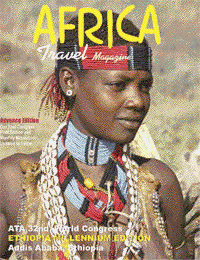 Ethiopia's
lower Omo Valley near the Kenya border is home to a
remarkable blend of ethnic groups. With lifestyles
are as varied as the tribes themselves, each finds
unique ways in which to develop and express its own
artistic flair. Our journalist team of Ogo Sow,
Mary Ellen Schultz and Syvia Mracky from the USA
and myself representing Canada, had been
anticipating this trip for months. As a reward we
were amazed by the fascinating ethnic treasures
discovered and friendships formed during this week
long tour arranged by Her Excellency Tadelech
Dalacho State Minister for Tourism, our gracious
host. Ethiopia's
lower Omo Valley near the Kenya border is home to a
remarkable blend of ethnic groups. With lifestyles
are as varied as the tribes themselves, each finds
unique ways in which to develop and express its own
artistic flair. Our journalist team of Ogo Sow,
Mary Ellen Schultz and Syvia Mracky from the USA
and myself representing Canada, had been
anticipating this trip for months. As a reward we
were amazed by the fascinating ethnic treasures
discovered and friendships formed during this week
long tour arranged by Her Excellency Tadelech
Dalacho State Minister for Tourism, our gracious
host.
Heading south from
Addis Ababa, one of the
first attractions on our tour agenda was
a visit to the Crater
Lakes at Debre Zeit and
the three Rift Valley Lakes of Shala,
Abyata and Langano,
teeming with bird life -
a colorful array from pelicans and flamingos
to storks and assorted
waterfowl. Later on
we were impressed by the homes and
cultural displays
presented by the Sidamo
tribe. Another
popular attraction was Arba Minch,
which means 40 springs in Amharic.
a tribute to the
bubbling streams that spring up
amid the undergrowth of a luxuriant
groundwater forest.
Here the Wolayta people
welcomed us to their village, where
they cultivate cereal
crops, cotton and tobacco.
Their large,
beehive-shaped huts are
adorned with one or
more large ostrich eggs
perched near the
roof as fertility symbols.
In the afternoon we
entered the town of
Chencha for a
friendly visit with the Dorze
people. This well
known tribe is famous
for weaving and for
their bamboo homes,
each with its own
small garden surrounded
by beds of spices
and cabbage and tobacco
sorghum and the
false banana. Should their
dwellings begin to
rot or become attacked by
an army of
termites, the villagers dig them
up and sew bamboo
struts around the base to
preserve the shape.
The Dorze name is synonymous
with the best in
woven cotton cloth,
a good reason why
Chencha is famous for its
fine cotton gabbis
or shawls.
Our tour group
enjoyed dinner at Swaynes
Hotel, with
spectacular views of the Chamo
and Abaya lakes and
the Netch Sar Park.
Owned and operated
by the Greenland
Group, this
attractive hotel offers 40 guest
rooms, each
furnished with artistically designed
Dorze furniture.
The exterior of each
bungalow is
constructed of bamboo and patterned
after the Dorze
tribal homes with their
high roofs. Each
unit is covered with bamboo
and the roof is
thatched with leaves from
the false banana
tree. The design in front
resembles an
elephant trunk, as typical Dorze
style. We were
impressed with the interiors
which reflect the
richest elements of Ethiopian
Culture. Materials
used are all ecological,
natural and
originate entirely from the
surrounding area.
There is also a naturalist
pathway to the
underground springs, ideal
for bird watching
and scenic views.
The lake shores and
islands of Abaya and
Chamo are populated
by farming communities
of the Ganjule and
Guji, both of whom
also have developed
ancient traditions for
hunting hippos. The
Guji ply the waters of
Lake Abaya in the
curved high prowed ambatch
boats, similar to
those craft depicted
on the tombs of the
ancient Egyptian pharaohs.
Surprisingly, an
ambatch is capable
of transporting
several full sized cattle at
one time and sturdy
enough to withstand attack
by large
crocodiles, which are present
in both lakes. Lake
Chamo is a good place
to view crocodiles
lounging in the sandy
beaches and sun
with clear blue water of its
northern shores.
Lake Abaya waters are reddish-
brown in color due
to heavy mineral
deposits.
As we soon
discovered, the rainy season
can bring sudden
flash flooding at low spots
on the highway and
side roads. Our media
team had a minor
incident when one of the
Awassa Ministry of
Tourism vehicles was
swept away by the
swift water. Fortunately
a small group of
Hamar villagers arrived in
time to retrieve
the vehicle from the rushing
current and help
carry our luggage across
the river. These
colorful young men and
women were
fantastic, friendly and attractive.
It was a memorable
moment.
Next morning's
visit to Netch Sar Park
provided
spectacular views of the lake,
with its variety of
wildlife such as Swaynes
Hartebeest, Zebras,
Kudu, Burchil's Zebra
and various species
of birds. Lunch was
served in Arba
Minch. We also enjoyed a
visit with the
Erbore people, noted for their
extensive use of
jewelry. In our afternoon
boat trip on Lake
Chamo we had a close
encounter with
hippos, and had a wary look
at the local
crocodiles, which are among
the longest in
Africa, over 6 meters. We
enjoyed dinner and
a comfortable night's
sleep as guests of
the Swaynes Hotel.
My special thanks
to our driver Teshome
Kebede, guide Abdi
Tenna Awassa, Green
Land Tours and the
Swaynes Hotel.
This article will
be continued in the next
update of this
edition and on our powerful
web site:
www.africa-ata.org/ethiopia.
htm/ You can
download this complete issue
and
others
|
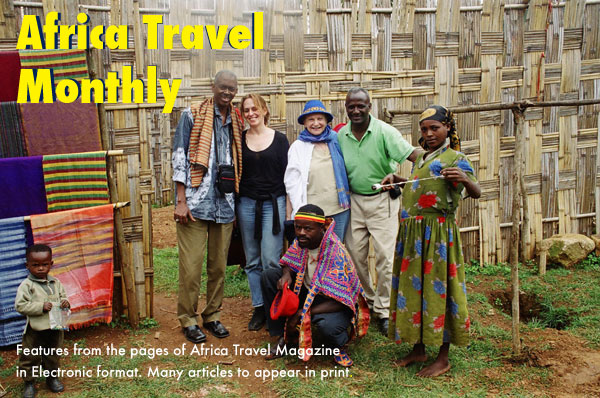 ..Click
above photo for pdf version of World
Edition.
..Click
above photo for pdf version of World
Edition.

 and
black charcoal to decorate their bodies. You can
boat to visit the Muguji tribal area for an
immersion in Muguji culture. The Muguji trap small
game and collect honey and wild fruits. Great
fishermen, one of the Muguji specialties is hunting
crocodiles. The Mursi tribe is famous worldwide for
the clay lip dishes, originally worn by the women,
as a means of avoiding capture as slaves. Just so
you know, they remove the clay plates at meal time.
Surrounded by mountains and three rivers, the Mursi
homeland is one of my most isolated regions. Like
the Maasai of neighboring Kenya, the Mursi have a
fierce reputation as guardians of their precious
grazing lands. The men often wore light scars on
their shoulders after killing an enemy and have
geometric patterns on their heads. For dances and
ceremonies they adorn their bodies with white
chalk. The Nyagatom live on the Omo River's western
banks near the Kenya border. Numbering over 7,000,
they have a war-like history. Small groups living
along the Omo specialize in hunting crocodiles,
usually from a light dugout canoes, using harpoons.
The men wear a blue and ochre clay clair hair bun
with ostrich feathers. The elders of both sexes
wear a plug on their lower lip - the female version
is made from copper.
and
black charcoal to decorate their bodies. You can
boat to visit the Muguji tribal area for an
immersion in Muguji culture. The Muguji trap small
game and collect honey and wild fruits. Great
fishermen, one of the Muguji specialties is hunting
crocodiles. The Mursi tribe is famous worldwide for
the clay lip dishes, originally worn by the women,
as a means of avoiding capture as slaves. Just so
you know, they remove the clay plates at meal time.
Surrounded by mountains and three rivers, the Mursi
homeland is one of my most isolated regions. Like
the Maasai of neighboring Kenya, the Mursi have a
fierce reputation as guardians of their precious
grazing lands. The men often wore light scars on
their shoulders after killing an enemy and have
geometric patterns on their heads. For dances and
ceremonies they adorn their bodies with white
chalk. The Nyagatom live on the Omo River's western
banks near the Kenya border. Numbering over 7,000,
they have a war-like history. Small groups living
along the Omo specialize in hunting crocodiles,
usually from a light dugout canoes, using harpoons.
The men wear a blue and ochre clay clair hair bun
with ostrich feathers. The elders of both sexes
wear a plug on their lower lip - the female version
is made from copper. Ethiopia's
lower Omo Valley near the Kenya border is home to a
remarkable blend of ethnic groups. With lifestyles
are as varied as the tribes themselves, each finds
unique ways in which to develop and express its own
artistic flair. Our journalist team of Ogo Sow,
Mary Ellen Schultz and Syvia Mracky from the USA
and myself representing Canada, had been
anticipating this trip for months. As a reward we
were amazed by the fascinating ethnic treasures
discovered and friendships formed during this week
long tour arranged by Her Excellency Tadelech
Dalacho State Minister for Tourism, our gracious
host.
Ethiopia's
lower Omo Valley near the Kenya border is home to a
remarkable blend of ethnic groups. With lifestyles
are as varied as the tribes themselves, each finds
unique ways in which to develop and express its own
artistic flair. Our journalist team of Ogo Sow,
Mary Ellen Schultz and Syvia Mracky from the USA
and myself representing Canada, had been
anticipating this trip for months. As a reward we
were amazed by the fascinating ethnic treasures
discovered and friendships formed during this week
long tour arranged by Her Excellency Tadelech
Dalacho State Minister for Tourism, our gracious
host.